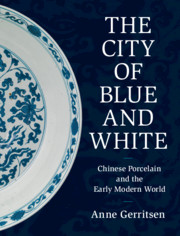Book contents
- The City of Blue and White
- The City of Blue and White
- Copyright page
- Dedication
- Contents
- Figures
- Maps
- Table
- Acknowledgements
- 1 The Shard Market of Jingdezhen
- 2 City of Imperial Choice: Jingdezhen, 1000–1200
- 3 Circulations of White
- 4 From Cizhou to Jizhou: The Long History of the Emergence of Blue and White Porcelain
- 5 From Jizhou to Jingdezhen in the Fourteenth Century: The Emergence of Blue and White and the Circulations of People and Things
- 6 Blue and White Porcelain and the Fifteenth-Century World
- 7 The City of Blue and White: Visualizing Space in Ming Jingdezhen, 1500–1600
- 8 Anxieties over Resources in Sixteenth-Century Jingdezhen
- 9 Skilled Hands: Managing Human Resources and Skill in the Sixteenth-Century Imperial Kilns
- 10 Material Circulations in the Sixteenth Century
- 11 Local and Global in Jingdezhen’s Long Seventeenth Century
- 12 Epilogue: Fragments of a Global Past
- Notes
- Bibliography
- Index
8 - Anxieties over Resources in Sixteenth-Century Jingdezhen
Published online by Cambridge University Press: 24 February 2020
- The City of Blue and White
- The City of Blue and White
- Copyright page
- Dedication
- Contents
- Figures
- Maps
- Table
- Acknowledgements
- 1 The Shard Market of Jingdezhen
- 2 City of Imperial Choice: Jingdezhen, 1000–1200
- 3 Circulations of White
- 4 From Cizhou to Jizhou: The Long History of the Emergence of Blue and White Porcelain
- 5 From Jizhou to Jingdezhen in the Fourteenth Century: The Emergence of Blue and White and the Circulations of People and Things
- 6 Blue and White Porcelain and the Fifteenth-Century World
- 7 The City of Blue and White: Visualizing Space in Ming Jingdezhen, 1500–1600
- 8 Anxieties over Resources in Sixteenth-Century Jingdezhen
- 9 Skilled Hands: Managing Human Resources and Skill in the Sixteenth-Century Imperial Kilns
- 10 Material Circulations in the Sixteenth Century
- 11 Local and Global in Jingdezhen’s Long Seventeenth Century
- 12 Epilogue: Fragments of a Global Past
- Notes
- Bibliography
- Index
Summary
This chapter focuses on the question of resources. Who owned the wood required for firing the kilns, and who could set the price of that wood? Who had access to the equipment and tools that furnished the various workshops, and who controlled the expensive pigments required in the production of fine ceramics? Questions over ownership and price, access and control arose in all of the stages of the production process. For the representatives of the imperial administration, i.e. the officials who were posted in the local county capital, Fuliang, and had supervisory responsibilities over the production of the porcelains that would go on to make up the imperial tribute, there was most at stake. For these administrators, the fluidity that characterised the movement of resources amounted to a loss of control over the costs of production and thereby over the goods they needed to supply. The flows of natural resources brought about the desire of the administrators to stem those flows and assert their control over them, but ultimately, their control was entirely elusive.
Keywords
- Type
- Chapter
- Information
- The City of Blue and WhiteChinese Porcelain and the Early Modern World, pp. 153 - 174Publisher: Cambridge University PressPrint publication year: 2020

